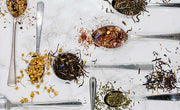10 Ways to Eat Your Sunscreen this Summer

It's summertime! Time to get out and play...but it's also time to focus on our skin and protecting it from the elements as we spend more time outdoors. Our mission at Tealeavz is to share ideas with our community to help keep you healthy – and how tea can play a role. We hope you enjoy this piece by our guest author, and learn how to protect your skin while enjoying every minute of summer.
1. Tea, both green and black, contains catechins, which help prevent and repair skin damage, help reduce inflammation, and protect against UV-induced skin cancers.
Tea also contains tannic acid and theobromine, which, applied topically, can soothe sunburn and repair damage.
Eat this: Purée matcha green tea powder with grated ginger, honey, and coconut milk, then freeze in an ice cream maker. Or steep lapsang souchong tea in hot water to make a strong, smoky stock to use for cooking rice. For a refreshing treat combine cooled green tea with grapefruit juice concentrate, pomegranate juice, and sparkling water.
2. Strawberries are rich in vitamin C, a powerful skin-protective antioxidant that reduces sun damage, wrinkles, and dry skin.
In combination with beta-carotene and vitamin E, it can protect against skin cancer and reduce sunburns. Other good sources of vitamin C include broccoli, peppers, grapefruit, oranges, and kiwi.
Eat this: Drizzle fresh strawberries with balsamic vinegar, sprinkle with minced basil, and top with a dollop of vanilla yogurt; dip strawberries in extra-dark chocolate; add sliced strawberries to a salad of arugula, spinach, and pine nuts.
3. Avocados are rich in fats that protect the skin cells from UV damage and inflammation, repair DNA, and enhance the availability of sun-protective nutrients from other fruits and vegetables.
Eat this: Add avocados to smoothies; purée avocados with lemon juice and olive oil for a healthy salad dressing; combine avocado chunks with corn kernels, diced peppers, onions, and lime juice for an easy salsa.
4. Olive oil contains oleuropein, the compound that gives extra-virgin olive oil its pungent taste.
It also protects against UV-induced wrinkling, skin damage, cancer, and tumor growth. Whole olives are also rich in oleuropein.
Eat this: Combine olive oil and rosemary in a glass jar and let steep for a fragrant, herb-scented oil; mix olive oil with softened pasture butter and minced chives for a smooth, buttery spread.
5. Eggplant contains anthocyanidins, potent antioxidants that inhibit skin cancer and damage caused by UV exposure.
Other good sources include blueberries, red onions, red cabbage, and black rice.
Eat this: Cut eggplant into strips, toss with garlic, thyme, and olive oil, and roast until tender; halve and roast eggplants, then scoop the flesh into a food processor and purée with olive oil, tahini, lemon juice, and garlic; cut crosswise into ¼-inch slices and grill over hot coals, then sprinkle with minced rosemary.
6. Cacao nibs are exceptionally rich in flavanols, antioxidants that protect skin from sun damage, increase blood circulation to the skin, improve hydration, and reduce signs of aging.
Commercial processing dramatically reduces levels of antioxidants, so unprocessed chocolate is best.
Eat this: Grind cacao nibs in a coffee grinder and add to ground coffee beans before brewing; stir cacao nibs and fresh raspberries into vanilla Greek yogurt; combine cacao nibs, whole oats, walnuts, pumpkin seeds, and coconut oil, and bake until crunchy for granola.
7. Carrots are high in beta-carotene, an antioxidant that can protect skin cells from UV damage and improve the health and appearance of skin.
Sweet potatoes, winter squash, mango, and dark leafy greens are other good sources.
Eat this: Use a vegetable peeler to make long ribbons from carrots, then toss with olive oil, balsamic vinegar, and pistachios; stem carrots and purée with cooked white beans and garlic for an easy dip; grate carrots and add to pancake batter, along with cinnamon, cardamom, and nutmeg.
8. Tempeh contains isoflavones that can reduce inflammation, help inhibit skin cancer, and reduce sun damage and signs of skin aging.
Eat this: Crumble tempeh and add to chili instead of beef; stir-fry tempeh cubes with bell peppers in a ginger, soy, and honey sauce; brush tempeh cakes with oil and garlic powder, grill until golden brown, and shower with minced chives.
9. Broccoli is high in sulforaphane, a class of compounds found in cruciferous vegetables that were found in a petri dish study to prevent oxidative damage to the skin from sun exposure.
Other sources include cabbage, kale, Brussels sprouts, radishes, and arugula.
Eat this: Combine finely chopped broccoli with green onions, almonds, and a honey vinaigrette for a summery slaw; serve steamed and chilled broccoli spears with red pepper hummus for dipping; toss broccoli florets with olive oil, garlic, and red pepper flakes, and roast until tender.
10. Red grapes are rich in resveratrol, a type of polyphenol antioxidant that reduces inflammation and protects against skin cancer from UV exposure.
Other sources of resveratrol are red wine, cranberries, and peanuts.
Eat this: Freeze red grape juice in ice cube trays, then add to glasses of sparkling water for a refreshing summer beverage; braise whole red grapes, sliced fennel, and Brussels sprouts in olive oil until tender; add halved red grapes to a salad of endive, blue cheese, and toasted walnuts.
Written by Lisa Turner for Better Nutrition.





